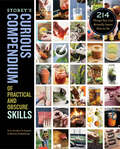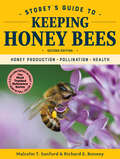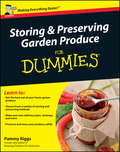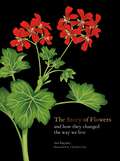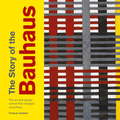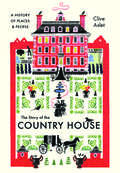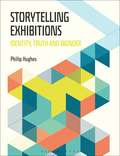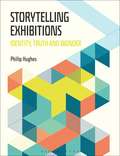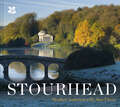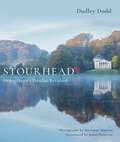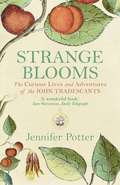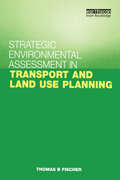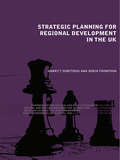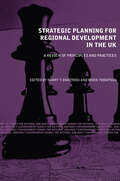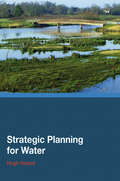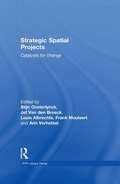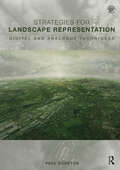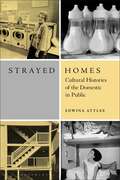- Table View
- List View
Storey's Curious Compendium of Practical and Obscure Skills: 214 Things You Can Actually Learn How to Do
by How-To Experts at Storey PublishingHave you ever wondered how to capture a swarm of bees? Predict the weather by the clouds? And just how do you darn a pair of socks, anyway? Anyone curious about the myriad ways people have taught themselves to make, grow, and build things will find everything they&’ve ever wondered about in this colorful, inviting volume. With dozens of useful and intriguing visual tutorials selected from Storey&’s extensive library of how-to books, you can learn how to carve a turkey, create a butterfly garden, set up a dog agility course, keep a nature sketchbook, navigate by the stars, and more. Whether you plan to &“do it yourself&” or just love reading about how things are done, this rich compendium will educate, fascinate, spark conversation, and inspire new hobbies and experiences.
Storey's Guide to Keeping Honey Bees, 2nd Edition: Honey Production, Pollination, Health (Storey’s Guide to Raising)
by Malcolm T. Sanford Richard E. BonneyThis trusted handbook is a must-have for novice and seasoned beekeepers alike. Now totally redesigned and featuring color photos and graphics, the second edition also includes up-to-date information on honey bee health. The go-to reference presents comprehensive yet accessible information on everything from planning hives and installing a colony to preventing disease and managing productive hives that will bear bountiful honey harvests year after year. This publication conforms to the EPUB Accessibility specification at WCAG 2.0 Level AA.
Storing and Preserving Garden Produce For Dummies
by Pammy RiggsGrowing your own food is more popular than ever. But what do you do if you find yourself with a glut of beans, peas or carrots? How can you make the most of your garden produce and cut down on those trips to the supermarket? This book provides everything you need to make your home-grown produce last, covering fruit, vegetables, herbs and even eggs. Storing and Preserving Garden Produce For Dummies: Covers the main methods of storing and preserving, such as clamping, cool storage, freezing, drying, salting, pickling, fermenting and preserving with sugar Includes information on a huge range of produce - almost everything you could ever want to grow in your back garden Explains what methods of storing and preserving are most suitable for each item of produce Also contains a wealth of recipes to help you on your way to making the perfect jams, chutneys and pickles
Storing and Preserving Garden Produce For Dummies
by Pammy RiggsGrowing your own food is more popular than ever. But what do you do if you find yourself with a glut of beans, peas or carrots? How can you make the most of your garden produce and cut down on those trips to the supermarket? This book provides everything you need to make your home-grown produce last, covering fruit, vegetables, herbs and even eggs. Storing and Preserving Garden Produce For Dummies: Covers the main methods of storing and preserving, such as clamping, cool storage, freezing, drying, salting, pickling, fermenting and preserving with sugar Includes information on a huge range of produce - almost everything you could ever want to grow in your back garden Explains what methods of storing and preserving are most suitable for each item of produce Also contains a wealth of recipes to help you on your way to making the perfect jams, chutneys and pickles
The Story of Flowers: And How They Changed the Way We Live
by Noel KingsburyThroughout history flowers have been an integral part of human survival and culture – as food, for medicine, to express feelings, as symbols, to commemorate and celebrate, and to decorate. Their shapes, colours, scents and textures have always attracted us, as they do animals and insects. Flowers are used as luxury spices (saffron), and as colouring and flavouring agents – marigolds fed to chickens make eggs more yellow and lavender was Elizabeth I’s favourite flavour of jam. Flowers are full of symbolic meaning: violets represent modesty, daises purity and daffodils unrequited love. And they have always played an important role in culture through myths and legends, literature and the decorative arts. This delightful new book brings together 100 of the world’s flowers to tell their remarkable stories. Each flower is richly illustrated in colour and accompanied by facts about each species and what role it has played in our culture and history.
The Story of Kew Gardens
by Lynn Parker Kiri Ross-JonesThis splendidly illustrated book about the world famous botanic gardens at Kew examines their historic impact and importance. With 250 fascinating photographs, many of them previously unseen, it describes the botanical, social, cultural, political and technological developments of the past two centuries and highlights the pivotal role that plants have played in British life. The tale of Kew Gardens embraces a wide range of themes, including: plant hunters, ecologists, explorers and other pioneers; the evolution of building and garden design; influential directors, architects and landscape gardeners; the gardens as a vital public resource; digging for victory - Kew in wartime.
The Story of the Bauhaus (The Story of ...)
by Frances AmblerNow 100 years old, the Bauhaus still looks just as fresh today as it did when it began. It was a place to experiment and embrace a new creative freedom. Thanks to this philosophy, the Bauhaus still shapes the world around us. Trace The Story of the Bauhaus through the 100 personalities, designs, ideas and events that shaped this monumental movement. Learn about leaders Paul Klee, Walter Gropius, Anni Albers and Wassily Kandinsky; witness groundbreaking events and wild parties that would revolutionise contemporary design; and discover a range of innovative ideas and new ways of thinking.
The Story of the Country House: A History of Places and People
by Clive AsletThe fascinating story of the evolution of the country house in Britain, from its Roman precursors to the presentThe Story of the Country House is an authoritative and vivid account of the British country house, exploring how they have evolved with the changing political and economic landscape. Clive Aslet reveals the captivating stories behind individual houses, their architects, and occupants, and paints a vivid picture of the wider context in which the country house in Britain flourished and subsequently fell into decline before enjoying a renaissance in the twenty-first century. The genesis, style, and purpose of architectural masterpieces such as Hardwick Hall, Hatfield House, and Chatsworth are explored, alongside the numerous country houses lost to war and economic decline. We also meet a cavalcade of characters, owners with all their dynastic obsessions and diverse sources of wealth, and architects such as Inigo Jones, Sir John Vanbrugh, Robert Adam, Sir John Soane and A.W.N. Pugin, who dazzled or in some cases outraged their contemporaries. The Story of the Country House takes a fresh look at this enduringly popular building type, exploring why it continues to hold such fascination for us today.
Storytelling Exhibitions: Identity, Truth and Wonder
by Philip HughesStorytelling Exhibitions describes the role and practice of modern 'spatial storytellers' and looks at the potential of exhibitions to shape our understanding of the world. It explains how curators, designers, artists and scientists combine to tell powerful stories through exhibition design. Exhibition designer and educator Philip Hughes shows how contemporary tools and technologies - digital reconstruction, 3D scanning and digital archives – interweave with traditional forms of informing, displaying and promoting to create powerful narrative spaces. Whether telling stories of politics, trends, society, war, science or history, Storytelling Exhibitions provides inspiration and guidance on designing installations which change the way we think. Examples included from:Te Papa, Wellington, New ZealandNational Museum of African American History and Culture, Washington, USAWeltmuseum Wien, AustriaSanta Cruz Museum of Art and History, USLascaux: Centre International de l'Art Pariétal in Montignac, FranceStapferhaus, Lenzburg, SwitizerlandMicropia, Amsterdam, Netherlands…and many more
Storytelling Exhibitions: Identity, Truth and Wonder
by Philip HughesStorytelling Exhibitions describes the role and practice of modern 'spatial storytellers' and looks at the potential of exhibitions to shape our understanding of the world. It explains how curators, designers, artists and scientists combine to tell powerful stories through exhibition design. Exhibition designer and educator Philip Hughes shows how contemporary tools and technologies - digital reconstruction, 3D scanning and digital archives – interweave with traditional forms of informing, displaying and promoting to create powerful narrative spaces. Whether telling stories of politics, trends, society, war, science or history, Storytelling Exhibitions provides inspiration and guidance on designing installations which change the way we think. Examples included from:Te Papa, Wellington, New ZealandNational Museum of African American History and Culture, Washington, USAWeltmuseum Wien, AustriaSanta Cruz Museum of Art and History, USLascaux: Centre International de l'Art Pariétal in Montignac, FranceStapferhaus, Lenzburg, SwitizerlandMicropia, Amsterdam, Netherlands…and many more
Stourhead
by Stephen AndertonA beautifully illustrated celebration of Stourhead, featuring the legendary Georgian landscape garden in glorious autumn colour with essays by head gardener Alan Power.
Stourhead: Henry Hoare's Paradise Revisited
by Dudley Dodd'Brings both house and garden vividly to life... A magnificent achievement' Gardens Illustrated'A finely crafted work... it is an important record of the history of one of the country's most splendid estates' The English GardenThe Palladian house of Stourhead, in Wiltshire, occupies a plateau above the confluence of three valleys. When you cross the south lawn and descend the tree-hung slopes, you glimpse a lake adorned with classical temples. Continue and you will find an allegorical grotto; a gothick hideaway; a Pantheon of demi-gods and, on high, a deserted temple to Apollo. To the west Alfred's Tower commands views over three counties, a gaunt landmark to English monarchy and patriotism.This is how in Georgian times Henry Hoare – known as Henry the Magnificent – would have explored the garden he designed. Generations of the Hoare family, bankers who combined service with enlightened patronage and philanthropy, have developed and cultivated the garden at Stourhead, and for many its breathtaking vistas are paradise.Dudley Dodd charts the owners of Stourhead and the history of the landscape, house and art collection. He describes how flights of folly, individual flair, taste and careful stewardship have nurtured a national treasure, which is among the finest English landscape gardens and, since 1946, a jewel of The National Trust. The stunning new pictures by the renowned photographer Marianne Majerus provide an up to date record of this enduring Elysium.
Strange Blooms: The Curious Lives and Adventures of the John Tradescants
by Jennifer PotterIn seventeenth-century Britain, a new breed of 'curious' gardeners were pushing at the frontiers of knowledge and new plants were stealing into Europe from East and West. John Tradescant and his son were at the vanguard of this change - as gardeners, as collectors and above all as exemplars of an age that began in wonder and ended with the dawning of science. Jennifer Potter's book vividly evokes the drama of their lives and takes its readers to the edge of an expanding universe. Strange Blooms is a magnificent pleasure for gardeners and non-gardeners alike.This 'wonderful book' (Jane Stevenson, Daily Telegraph) describes the remarkable lives and times of the John Tradescants.
Strategic Environmental Assessment in Transport and Land Use Planning
by Thomas B. FischerAssessing the full scale of environmental impacts is essential for effective planning of transport and land use. This is an analysis of transport and land-use planning using strategic environmental assessment (SEA). It establishes the effectiveness of SEA through comparative studies of practice in three countries: Britain, the Netherlands and Germany. The author shows that use of SEA is widespread but far from systematic. He demonstrates the advantages of adopting a systematic application of a comprehensive form of SEA derived from all the major current approaches. Only once this approach is fully understood and systematically applied will all the full benefits be achieved and environmental impacts be minimalized.
Strategic Environmental Assessment in Transport and Land Use Planning
by Thomas B. FischerAssessing the full scale of environmental impacts is essential for effective planning of transport and land use. This is an analysis of transport and land-use planning using strategic environmental assessment (SEA). It establishes the effectiveness of SEA through comparative studies of practice in three countries: Britain, the Netherlands and Germany. The author shows that use of SEA is widespread but far from systematic. He demonstrates the advantages of adopting a systematic application of a comprehensive form of SEA derived from all the major current approaches. Only once this approach is fully understood and systematically applied will all the full benefits be achieved and environmental impacts be minimalized.
Strategic Planning for Regional Development in the UK (Natural and Built Environment Series)
by Harry T. Dimitriou Robin ThompsonWith contributions from leading academics and practitioners, Strategic Planning for Regional Development in the UK is the most up-to-date treatment of a fast-changing subject. The book discusses: The evolution of regional planning in the UK and the strategic thinking involved The spatial implications of regional economic development policies The methods and techniques needed for the implementation of strategic planning for regional development How strategic planning for regional development is currently put into practice in three UK regions with different priorities. Strategic Planning for Regional Development in the UK is essential reading for students and academics working within strategic and regional planning and provides policy makers and practitioners with a comprehensive and thought provoking introduction to this critically important emerging field.
Strategic Planning for Regional Development in the UK (Natural and Built Environment Series)
by Harry T. Dimitriou Robin ThompsonWith contributions from leading academics and practitioners, Strategic Planning for Regional Development in the UK is the most up-to-date treatment of a fast-changing subject. The book discusses: The evolution of regional planning in the UK and the strategic thinking involved The spatial implications of regional economic development policies The methods and techniques needed for the implementation of strategic planning for regional development How strategic planning for regional development is currently put into practice in three UK regions with different priorities. Strategic Planning for Regional Development in the UK is essential reading for students and academics working within strategic and regional planning and provides policy makers and practitioners with a comprehensive and thought provoking introduction to this critically important emerging field.
Strategic Planning for Water
by Hugh HowesStrategic Planning for Water examines the neglected relationship between planning for water and spatial planning. It provides the background to sustainable water management and assistance to spatial planners in understanding the complex water environment. This extremely topical book examines the challenges of:how to ensure that water supplies are a
Strategic Planning for Water
by Hugh HowesStrategic Planning for Water examines the neglected relationship between planning for water and spatial planning. It provides the background to sustainable water management and assistance to spatial planners in understanding the complex water environment. This extremely topical book examines the challenges of:how to ensure that water supplies are a
Strategic Spatial Projects: Catalysts for Change (RTPI Library Series)
by Stijn Oosterlynck Jef Van Den Broeck Louis Albrechts Frank Moulaert Ann VerhetselStrategic Spatial Projects presents four years of case study research and theoretical discussions on strategic spatial projects in Europe and North America. It takes the position that planning is not well equipped to take on its current challenges if it is considered as only a regulatory and administrative activity. There is an urgent need to develop a mode of planning that aims to innovate in spatial as well as social terms. This timely, important book is for spatial planning, urban design and community development and policy studies courses. For academics, researchers and students in planning, urban design, urban studies, human and economic geography, public administration and policy studies.
Strategic Spatial Projects: Catalysts for Change (RTPI Library Series)
by Stijn Oosterlynck Jef Van Den Broeck Louis Albrechts Frank Moulaert Ann VerhetselStrategic Spatial Projects presents four years of case study research and theoretical discussions on strategic spatial projects in Europe and North America. It takes the position that planning is not well equipped to take on its current challenges if it is considered as only a regulatory and administrative activity. There is an urgent need to develop a mode of planning that aims to innovate in spatial as well as social terms. This timely, important book is for spatial planning, urban design and community development and policy studies courses. For academics, researchers and students in planning, urban design, urban studies, human and economic geography, public administration and policy studies.
Strategies for Landscape Representation: Digital and Analogue Techniques
by Paul CuretonStrategies for Landscape Representation discusses a variety of digital and analogue production techniques for the representation of landscape at multiple scales. Careful consideration is required to represent time, and to ensure accuracy of representation and evaluation in the landscape.Written as a guide for making appropriate selection of a wide variety of visualisation tools for students and built environment professionals with an interest in landscape, the book charts emerging technologies and historical contexts whilst also being relevant to landscape legislation such as Building Information Modelling (BIM) and Landscape Assessment. This book is an innovation-driven text that encourages readers to make connections between software, technology and analogue modes. The management, choice and combination of such modes can arguably narrow the unknown of landscape character, address the issues of representing time and change in landscape and engage and represent communities’ perceptions and experience of landscape.Showcasing international examples from landscape architecture, planning, urban design and architecture, artists, visualisers, geographers, scientists and model makers, the vitality of making and intrinsic value of representational work in these processes and sites is evidenced. An accompanying companion website provides access to original source files and tutorials totalling over a hundred hours in mapping and GIS, diagrams and notation, photomontage, 3D modelling and 3D printing.
Strategies for Landscape Representation: Digital and Analogue Techniques
by Paul CuretonStrategies for Landscape Representation discusses a variety of digital and analogue production techniques for the representation of landscape at multiple scales. Careful consideration is required to represent time, and to ensure accuracy of representation and evaluation in the landscape.Written as a guide for making appropriate selection of a wide variety of visualisation tools for students and built environment professionals with an interest in landscape, the book charts emerging technologies and historical contexts whilst also being relevant to landscape legislation such as Building Information Modelling (BIM) and Landscape Assessment. This book is an innovation-driven text that encourages readers to make connections between software, technology and analogue modes. The management, choice and combination of such modes can arguably narrow the unknown of landscape character, address the issues of representing time and change in landscape and engage and represent communities’ perceptions and experience of landscape.Showcasing international examples from landscape architecture, planning, urban design and architecture, artists, visualisers, geographers, scientists and model makers, the vitality of making and intrinsic value of representational work in these processes and sites is evidenced. An accompanying companion website provides access to original source files and tutorials totalling over a hundred hours in mapping and GIS, diagrams and notation, photomontage, 3D modelling and 3D printing.
Strayed Homes: Cultural Histories of the Domestic in Public
by Edwina AttleeStrayed Homes explores the blurring of public and private space. But whereas most writing about the public/private focusses on urban space, Strayed Homes focusses on the domestic – exploring those overlooked, everyday places where private and intimate activities take place in public.With four chapters set in four small, liminal spaces: the launderette, the greasy spoon, the fire escape, and the sleeper train - the book is part architectural history, part cultural history. It follows a series of allusions and impressions, to explore how films, adverts, books and anecdotes shape experiences of everyday architecture. Making a case for the poetic interpretation of space, the book can be used as a sourcebook for architects and designers as well as for theorists. It invites the reader – by embracing the notion of the 'strayed home' – to think again about concepts that are commonly invoked in the fields of architecture and urbanism, such as 'private', 'public' and 'home', and to rethink the emotional state of leaving home, intimacy in public, and lonely dreaming.
Strayed Homes: Cultural Histories of the Domestic in Public
by Edwina AttleeStrayed Homes explores the blurring of public and private space. But whereas most writing about the public/private focusses on urban space, Strayed Homes focusses on the domestic – exploring those overlooked, everyday places where private and intimate activities take place in public.With four chapters set in four small, liminal spaces: the launderette, the greasy spoon, the fire escape, and the sleeper train - the book is part architectural history, part cultural history. It follows a series of allusions and impressions, to explore how films, adverts, books and anecdotes shape experiences of everyday architecture. Making a case for the poetic interpretation of space, the book can be used as a sourcebook for architects and designers as well as for theorists. It invites the reader – by embracing the notion of the 'strayed home' – to think again about concepts that are commonly invoked in the fields of architecture and urbanism, such as 'private', 'public' and 'home', and to rethink the emotional state of leaving home, intimacy in public, and lonely dreaming.
